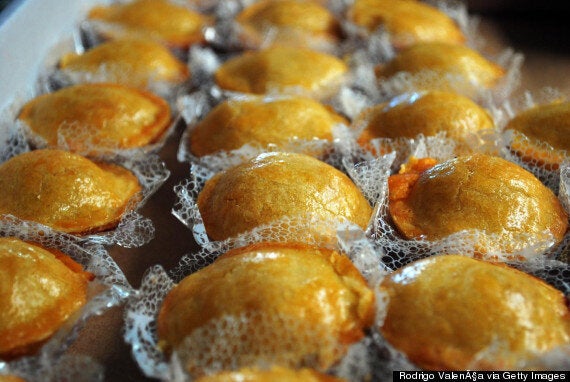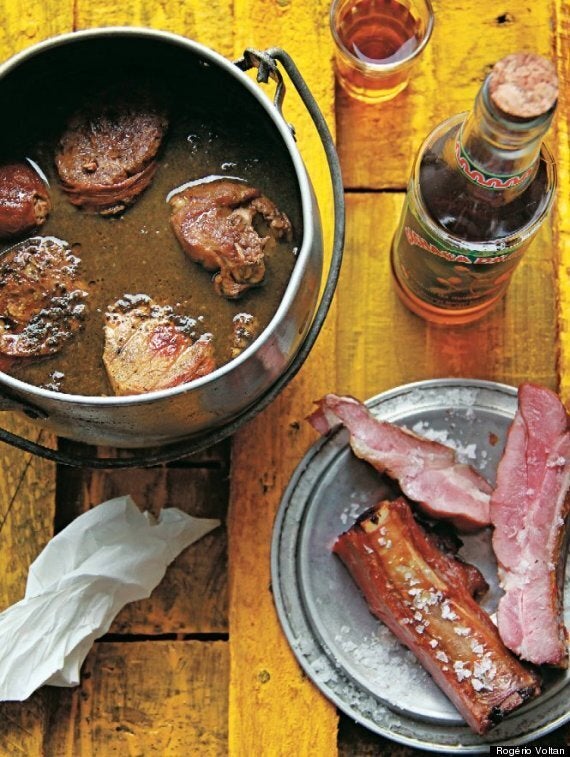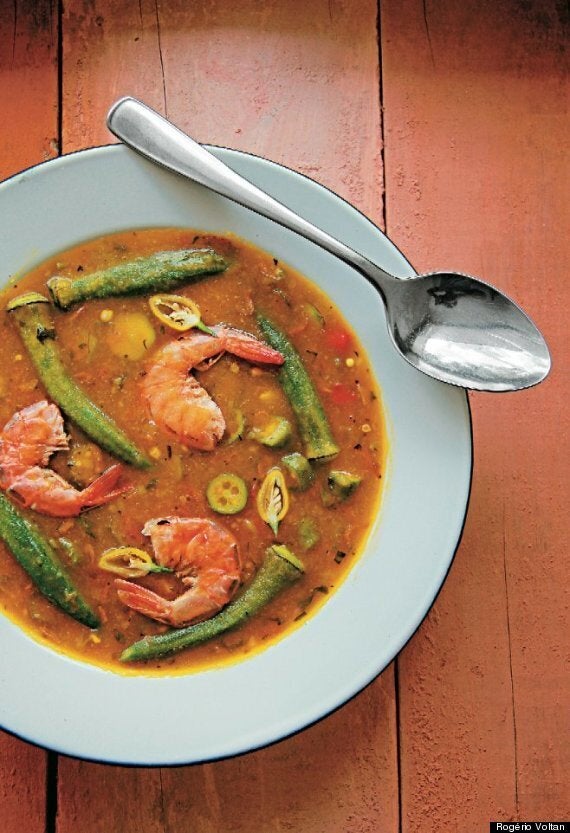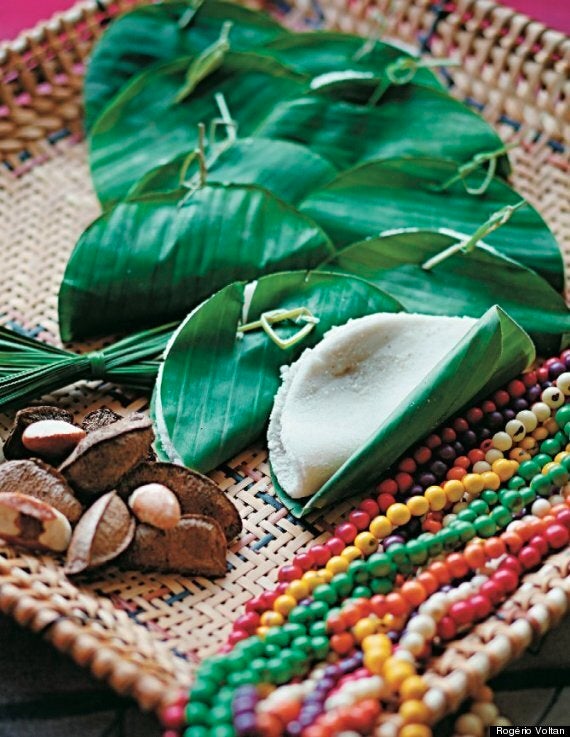Brazil may be better known for its drinks (caipirinha, anyone?) than street food, but that doesn't mean it doesn't offer a good spread via street cart. In Brazil, they are called salgados or salgadinhos - savoury snacks that fill a little hole before dinner.
Here, we've included three recipes from top Brazilian chefs Thiago Castanho and Luciana Bianchi, who know a thing or two about Brazilian fare. Bianchi is a Michelin chef with a background in molecular science, while Castanho is talented young chef.
But first, a quick potted summary of Brazilian street food:
Pamonha
If you don't know what pamonha is, you may shy away from the look of it. Essentially, it's corn. "Brazilian corn is very fibrous and not too sweet, so the mashed corn can go into the wrapper and be boiled directly in water," says The Good Blood Blog.

Empandinha
The Argentinians call them empanadas, the Cornish call them pasties and the Caribbeans call them patties. In Brazil, they are empandinhas.
"In Brazil our little pies are empadinhas, and they have the traditional fillings of shrimp or palm hearts or chicken (people experiment a lot with non-traditional fillings)," says The Good Blood.
Writing on a Taste Of Brazil, Saskia says: "Found in any lanchonete (snack shop), padaria (bakery), or cafe, empadinhas are the perfect savory snack to have with a good strong cup of coffee."
Acaraje
These are super yum and usually fried right in front of you at a cart.
Marcello Tully, the only Brazilian-born Michelin-starred chef in the UK says: "They are basically black eyed beans which have been peeled and crushed into a paste, then deep fried in palm oil. Once it’s cooked you cut it open and traditionally fill it with chicken, but at Kinloch we use langoustine, and where I was born in north-east Brazil they stuff them with vatapa, which is a shrimp-based filling."
Bolinhos de Arroz
"Brazilian fried rice fritters are a delicious solution for leftover rice. The rice is seasoned with onions and parsley, moistened with egg and milk, shaped into little balls and fried. In Rio de Janeiro, sardines and parmesan cheese are popular additions to this recipe, says South American Food.
Coxinha
For all you chicken lovers out there, coxinha is "a dough filled with shredded chicken then breadcrumbed and deep fried," says Tully.
"Some people love to eat them dotting each bite with some good hot red pepper sauce," says Authentic Brazilian Cuisine.
Maniçoba com costela de porco
Cassava leaf and pork stew served with pork ribs

One of the most emblematic dishes of the Brazilian Amazon, maniçoba is also known as ‘Amazonian feijoada’.
Serves 15
* 300g forequarter charque, cut into cubes
* 1 salted pig’s ear, roughly chopped
* 1 salted pig’s trotter, cut into 3 pieces
* 2kg ready-cooked cassava leaves
* 300g slab bacon, cut into 2cm cubes
* 300g bone-in smoked pork ribs, separated
* 400g bone-in pork neck, cut into 4cm pieces
* 4 bay leaves
* 40ml extra virgin olive oil
* 50g onion, finely diced
* 10g garlic, crushed
* 3 tbsp coarsely chopped cilantro
(Mexican/long coriander)
* 2 tbsp chopped coriander sprigs
* 2 cumari-do-Para or other mild yellow chillies, deseeded and chopped
* 1/2 tbsp ground cumin
* 1/2 tbsp freshly ground black pepper
1. Put the charque, pig’s ear and trotter in a large bowl. Cover with cold water and soak for 12 hours, changing the water every 4 hours to remove the excess salt.
2. Combine the precooked cassava leaves with 3 litres of water in a large, heavy-based pot. Cook over a medium heat for 12 hours, adding more water as needed to prevent it boiling dry.
3. Add the bacon and charque to the pot and cook over a low heat for a further 2 hours.
4. Add the pig’s ear and trotter, smoked pork ribs, pork neck and bay leaves to the pot. Continue cooking for a further 2 hours over a low heat.
5. Heat the olive oil in a frying pan and saute the onion, garlic, culantro, coriander, cumari-do-Para, cumin and black pepper. Add this to the pot of manicoba and cook for 30 minutes. Taste and add salt if necessary.
Salt pork ribs
* 1.5kg rack of pork ribs
* 1 tbsp chopped garlic
* 1 tbsp brown sugar
* 1 tbsp salt
* black pepper
* 1 tsp fennel seeds
* juice of 1/2 lime
6. To prepare the pork ribs, mix together the garlic, brown sugar, salt and pepper, fennel seeds and lime juice. Rub this mixture over the ribs and leave to marinate in the refrigerator for 1 hour. Preheat the oven to 180C (350F), gas mark 4. Wrap the rack of ribs in aluminium foil and bake for 1 hour.
7. Preheat a charcoal barbecue. Remove the ribs from the oven and discard the foil. Sit the ribs 40cm above the hot coals and chargrill for 5 minutes on each side or until golden brown. Cut the ribs into sections and serve with the manicoba.
Caruru paraense
Pará-style okra and shrimp curry

The origins of caruru point to a divided authorship between native Indians and Africans. This typical dish of Bahia state is nowadays associated with the African-Brazilian religious ritual, Candomblé, and served as a main course, as here, or as part of a banquet.
Serves 5
* 700g whole dried salt shrimps
* 40ml extra virgin olive oil
* 50g onion, finely chopped
* 1 tbsp crushed garlic
* 15g green pepper, diced
* 35g tomato, chopped
* 2 cumari-do-Para or other mild yellow
chillies, chopped
* 400g okra, cut into 1cm-thick rounds
* 1 bay leaf
* 250g fine, untoasted cassava flour
* pinch of ground cumin
* black pepper
* 20ml dende (palm) oil
* 11/2 tbsp hand-torn cilantro
* 11/2 tbsp hand-torn basil
* 150g jambu (Para cress/toothache plant) or watercress
* Brazilian-style white rice to serve
* 50g dried salt shrimps, heads removed
1. Soak the whole dried shrimps in plenty of cold water for 4 hours. Drain and peel, reserving the heads and shells.
2. Put the heads and shells in a colander and rinse well under cold running water. Transfer to a blender, add 1.4 litres of water and process until smooth. Pour the liquid into a large saucepan and bring to the boil over a high heat. Boil hard for 10 minutes to make a full-flavoured broth. Strain and set aside.
3. In a separate saucepan, heat the olive oil and saute the onion, garlic, green pepper, tomato and cumari-do-Para until softened.
4. Add the peeled shrimps and okra and saute for 1 minute. Stir in the shrimp broth and heat until simmering.
5. Add the bay leaf, then gradually add the cassava flour, stirring constantly with a whisk to prevent lumps forming. Cook for
7 minutes or until thickened.
6. Stir in the ground cumin, a little black pepper and the dende oil. Lower the heat and cook for 4 minutes.
7. Add the cilantro and basil, stirring to combine. Adjust the salt to taste and keep the caruru hot while you prepare the garnishes.
8. Rinse the dried shrimps under cold running water to remove excess salt. In a saucepan of boiling water, cook the shrimp
for 4 minutes then drain and set aside.
9. Bring another saucepan of water to the boil, add the jambu leaves and blanch them for 1 minute. Drain and refresh in a bowl of iced water to stop the cooking and keep the leaves bright green. Drain before plating.
10. To serve, place a spoonful of cooked white rice on serving plates, add a portion of caruru and garnish with the jambu leaves
and shrimps.
Tapioca molhada com leite de castanha
(Tapioca crepes with Brazil nut milk)

In Mosqueiro, a town next to Belém, the tapioqueiros (tapioca sellers) announce their arrival by shouting through the streets: "TAPIOQUEEEEEEEEEIRO!" People are used to being greeted by these voices and their sound is part of daily life. This recipe is one of the most traditional of our region. Usually coconut milk is the ingredient of choice, but in this version we use Brazil nut milk.
Makes 18
* 300g raw Brazil nuts
* 500g goma de mandioca or sweet tapioca starch
* 1 banana leaf (optional)
* salt
* 60g rapadura or dark muscovado sugar
* 3/4 tsp fennel seeds
1. In a saucepan, heat 1 litre of water to 60C. Carefully pour it into a blender, add the Brazil nuts and process for 3 minutes. Strain the milk into a bowl and reserve the strained nuts (you will need 200g of the ground nuts tofinish the recipe).
2. Combine the goma de mandioca and 2 litres of water in a mixing bowl and leave to stand for 1 hour. Carefully drain the water from the bowl, pouring it away slowly to leave the starch behind in the bottom of the bowl. Cover with a clean tea towel and leave it to stand for a further 1 hour, to absorbthe excess water.
3. Meanwhile, cut the banana leaf (if using) into 10cm diameter discs. Wave them quickly over an open flame to soften, then set aside.
4. Break the starch into pieces with a spoon, add some salt to taste and pass the mixture through a fine sieve to obtain a fine and fluffy powder.
5. Heat a small nonstick frying pan. Sprinkle some of the starch flour over the base of the pan in a thin, even layer. Cook for 30 seconds, then flip it over and cook for a further 30 seconds. Remove from the heat and set aside while you cook the remainder.
6. Cut out each crepe into circles using a 10cm diameterplain cookie cutter. Moisten each tapioca disc with the Brazil nut milk. Spread a little of the ground Brazil nuts, rapadura and fennel seeds over each of them.
7. Fold each tapioca disc in half and drizzle with some more Brazil nut milk. Wrap in a disc of banana leaf, secure with a cocktail stick and serve.
Brazilian Food by Thiago Castanho & Luciana Bianchi, published by Mitchell Beazley, £30